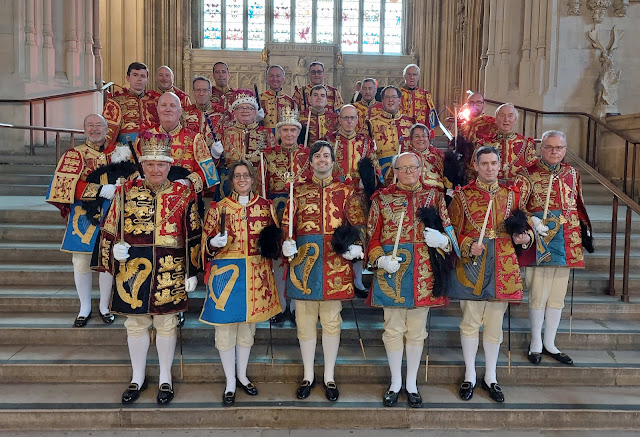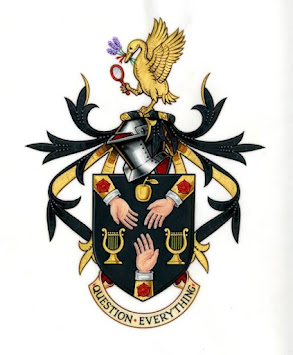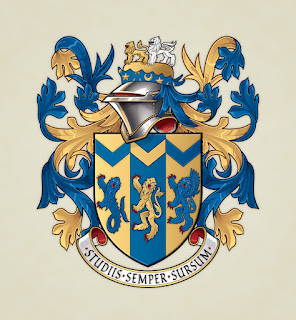The Profiles III - Philip Tibbetts, March Pursuivant
The Profiles No III – Philip Tibbetts
March Pursuivant of Arms Extraordinary
By Lance Sergeant David G Griffiths 86
The office of March Pursuivant dates to the time of King James V and holds some distinct antiquity. After nearly a century of vacancy, the office was recently filled by Philip Tibbetts, who was then, as he is now, Honorary Vexillologist to the Court of the Lord Lyon. His office of March relates to the border area between Scotland and England - the marches - and it must be a happy coincidence then that March himself occupies a charming home, with wife Kirsty and daughter Ysobel, that is a mere half-marathon's distance from the border itself.
DG: Good Morning. Let me ask some questions.
PT: Morning, certainly, happy to get stuck in.
DG: Heraldry has a particularly interesting place in Scottish history. How did you come to be interested in it?
PT: I think I was interested in vaguely heraldic issues, certainly ones of symbolism, from a young age. I certainly remember wondering whether there was any underlying meaning to the colours of my cub scout neckerchief. Then at High School we had a medieval week, as part of which someone came in to give a heraldry workshop. This captured my imagination, and I still remember the design I made, which today I would blazon as Argent a dragon rampant Gules, on a bordure Sable bezantée.
DG: You combine your role as March Pursuivant with Honorary Vexillologist to the Court of the Lord Lyon. Tell me about that, and how you came to that role?
PT: Working for the Flag Institute I had helped several communities, towns and counties, to agree the design of flags that the public could fly to express their pride in. The first in Scotland was Caithness, which I was able to help run as a competition process that still abided by requirements of Scottish heraldic law. This was a success and has led to more and more communities looking to follow suit.
DG: How did you come to be appointed March Pursuivant?
PT: My appointment as one of the officers of arms came off the continuing success of my vexillology role. In that role I get out and about across Scotland quite a lot – having worked with communities in the Islands as well as across the mainland – and being a full officer of arms with a uniform would obviously help raise the profile directly of the Court, heralds and heraldry even further around the whole country.
As I live in the border marches of the Scottish Uplands, I was delighted to have been given the office of March and am the first person to hold it in nearly a hundred years. The vexillology heritage of the area also seems rather fitting, with great displays at the Ridings and even the historical record of banners at the siege of Caerlaverock Castle.
DG: As an Officer of Arms, you have taken part in some tremendous state occasions, both in Scotland and England. Tell me a little about these events, and some key moments that stand out?
PT: Being involved in those events is, simply, not something that I had ever foreseen or expected throughout my life. Indeed, I had only been appointed as an officer nearly exactly a year before the death of Queen Elizabeth II. As it happens, I had been in Aberdeenshire for the flag competition there on the day she passed away. During those events I think everyone was focussed on performing our duties to the best of our abilities and it is only really when we look back at them that we can take pride in what we did. Writing up my memories of these experiences was very valuable to me in this regard.
DG: Outside of heraldry, I understand you have a professional role in the aerospace industry. Tell me about that?
PT: After leaving university I have worked in aerospace and defence. The flags and heraldry work were really initially only a hobby, but one that eventually evolved into a national responsibility over time. In my professional career I have mostly been focussed on the military air sector; first primarily on Eurofighter, then C-130 Hercules and then with a company working on hypersonic flight access. Sadly, the latter went bankrupt in October which has left me currently between jobs.
DG: Tell me a little about you, family, interests, etc.
PT: As anyone that has ever met me will testify to, I am very geeky. Indeed, I used to write a few articles for the Den of Geek website, and it was fun recently to discover that a few of those appear as refences in Wikipedia articles, such as that for the Ghostbusters: Afterlife film. Perhaps I am the real-world Sheldon Cooper.
DG: What are your current areas of special heraldic study/interest?
PT: My main area of study I suppose will always be vexillology, and there is plenty more for me to do there. However, whilst this has become something of a responsibility for me, I still find other areas of heraldry to take an interest. As well as coming up with interesting new designs, such as that for my colleague Carrick Pursuivant, the main such area that I am enjoying experimenting and developing in is the art of emblazonment. To me one of the fairly unique features, and greatest strengths, of heraldry is how various interpretations of a design still fall under the same technical description; in theory a single blazon can be emblazoned in a multitude of ways. Given the history and heritage of heraldry it is unsurprising that there are more traditional ways this is usually done, which is great and can help keep traditional arts and crafts techniques alive. However, I guess like in music where a particular song can be adapted for different instrumentations, I really enjoy experimenting with creating emblazonments of designs in non-traditional styles to see what the art of the possible might be.
PT: Morning, certainly, happy to get stuck in.
DG: Heraldry has a particularly interesting place in Scottish history. How did you come to be interested in it?
PT: I think I was interested in vaguely heraldic issues, certainly ones of symbolism, from a young age. I certainly remember wondering whether there was any underlying meaning to the colours of my cub scout neckerchief. Then at High School we had a medieval week, as part of which someone came in to give a heraldry workshop. This captured my imagination, and I still remember the design I made, which today I would blazon as Argent a dragon rampant Gules, on a bordure Sable bezantée.
DG: You combine your role as March Pursuivant with Honorary Vexillologist to the Court of the Lord Lyon. Tell me about that, and how you came to that role?
PT: Working for the Flag Institute I had helped several communities, towns and counties, to agree the design of flags that the public could fly to express their pride in. The first in Scotland was Caithness, which I was able to help run as a competition process that still abided by requirements of Scottish heraldic law. This was a success and has led to more and more communities looking to follow suit.
 |
| March Pursuivant outside his home near the marches, with daughter Ysobel. "There is always a flag flying." |
PT: My appointment as one of the officers of arms came off the continuing success of my vexillology role. In that role I get out and about across Scotland quite a lot – having worked with communities in the Islands as well as across the mainland – and being a full officer of arms with a uniform would obviously help raise the profile directly of the Court, heralds and heraldry even further around the whole country.
As I live in the border marches of the Scottish Uplands, I was delighted to have been given the office of March and am the first person to hold it in nearly a hundred years. The vexillology heritage of the area also seems rather fitting, with great displays at the Ridings and even the historical record of banners at the siege of Caerlaverock Castle.
 |
| Badge of office of March Pursuivant Originally designed by Elizabeth Roads LVO |
PT: Being involved in those events is, simply, not something that I had ever foreseen or expected throughout my life. Indeed, I had only been appointed as an officer nearly exactly a year before the death of Queen Elizabeth II. As it happens, I had been in Aberdeenshire for the flag competition there on the day she passed away. During those events I think everyone was focussed on performing our duties to the best of our abilities and it is only really when we look back at them that we can take pride in what we did. Writing up my memories of these experiences was very valuable to me in this regard.
DG: Outside of heraldry, I understand you have a professional role in the aerospace industry. Tell me about that?
PT: After leaving university I have worked in aerospace and defence. The flags and heraldry work were really initially only a hobby, but one that eventually evolved into a national responsibility over time. In my professional career I have mostly been focussed on the military air sector; first primarily on Eurofighter, then C-130 Hercules and then with a company working on hypersonic flight access. Sadly, the latter went bankrupt in October which has left me currently between jobs.
DG: Tell me a little about you, family, interests, etc.
PT: As anyone that has ever met me will testify to, I am very geeky. Indeed, I used to write a few articles for the Den of Geek website, and it was fun recently to discover that a few of those appear as refences in Wikipedia articles, such as that for the Ghostbusters: Afterlife film. Perhaps I am the real-world Sheldon Cooper.
 |
| March Pursuivant alongside other Scottish and English Officers of Arms |
PT: My main area of study I suppose will always be vexillology, and there is plenty more for me to do there. However, whilst this has become something of a responsibility for me, I still find other areas of heraldry to take an interest. As well as coming up with interesting new designs, such as that for my colleague Carrick Pursuivant, the main such area that I am enjoying experimenting and developing in is the art of emblazonment. To me one of the fairly unique features, and greatest strengths, of heraldry is how various interpretations of a design still fall under the same technical description; in theory a single blazon can be emblazoned in a multitude of ways. Given the history and heritage of heraldry it is unsurprising that there are more traditional ways this is usually done, which is great and can help keep traditional arts and crafts techniques alive. However, I guess like in music where a particular song can be adapted for different instrumentations, I really enjoy experimenting with creating emblazonments of designs in non-traditional styles to see what the art of the possible might be.
This started during the coronavirus lockdowns when I studied traditional Japanese monshō heraldry and seeing whether I could use its geometry, patterns and forms within the format and structure of Scottish heraldry. This followed a comment by the Japanese Consul-General on how my personal arms would have made the basis for a very good monshō. My daughter would later become a big fan of a Japanese cartoon, Digimon, which led me to work with an artist to explore the idea of emblazoning my badges of office in an anime style. Recently I have also been experimenting with heraldry based on the dark distant future of the Warhammer 40,000 universe, and a ‘shield maiden’ emblazonment for my wife who is a big fan of all things by J. R. R. Tolkien.
DG: Thank you for joining me.
PT: Thank you.
March Pursuivant has a tremendous following on social media, and indeed within the world of Scots heraldry. He can be found at www.vexillologist.scot for all matters relating to vexillology and heraldry.
Below: daughter Ysobel and Albany Herald leading the procession at the 2022 Festival of Heraldry











Comments
Post a Comment